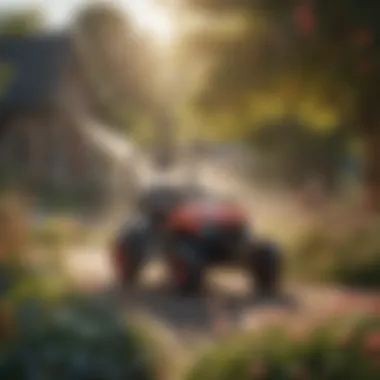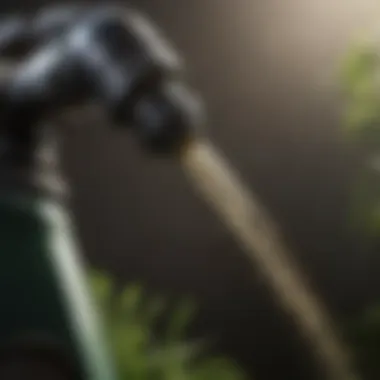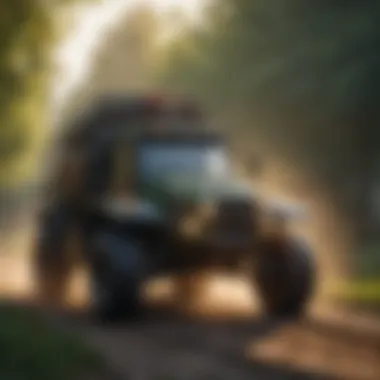The Ultimate Guide to Choosing the Best Garden Sprayer


Intro
Garden sprayers play a crucial role in effective gardening and agricultural practices. They are essential tools that help deliver water, fertilizers, and pesticides to crops and plants efficiently. Mastery of their usage can significantly influence productivity and health of the gardens or farms.
This guide aims to provide readers with a comprehensive understanding of garden sprayers, including how to choose the right type based on specific needs, maintenance tips for longevity, and the latest innovations in sprayer technology.
Research and Data Analysis
Understanding the context in which garden sprayers operate is essential for making informed decisions. Recent trends in agriculture and horticulture reveal a significant shift toward sustainable practices. This alteration is largely driven by the need to produce more food in an eco-friendly manner. As such, effective sprayer technology becomes vital in achieving efficiency in these sustainable practices.
Latest Trends in Agriculture and Horticulture
- Sustainable Agriculture: More farmers are using garden sprayers that minimize chemical runoff through targeted application.
- Smart Technologies: Many sprayers now integrate precision agriculture tools, allowing for real-time data collection on crop health.
- Environmental Concerns: A growing emphasis on organic farming promotes the use of sprayers that apply natural fertilizers and pesticides.
Statistical Insights into Crop Yields
Statistics show that farmers adopting modern sprayer technologies can enhance crop yields by as much as 20%. Improved methods of application lead to better absorption of nutrients and pesticides, resulting in healthier plants.
Best Practices and Techniques
To maximize the benefits of garden sprayers, it is essential to adopt best practices and techniques tailored for specific crops and conditions.
Efficient Crop Management Strategies
- Timing of Application: Apply at times when wind is low to avoid chemical drift.
- Correct Dilution: Ensure that fertilizers and pesticides are mixed accurately to avoid under or over-application.
- Regular Calibration: Sprayers should be calibrated regularly to ensure that they deliver the right amount of solution.
Sustainable Horticultural Techniques
Using environmentally friendly products and techniques can further amplify the positive impact of garden sprayers. Techniques include:
- Mulching: Helps retain moisture and reduces the need for frequent watering.
- Companion Planting: Introduces natural pest management, reducing the need for chemical application.
Pest and Disease Management
Identifying risks to crops is critical. Garden sprayers serve as a vital component in managing pests and diseases effectively.
Common Pests and Diseases in Crops
Some of the most threatening include:
- Aphids
- Fungal infections
- Weeds
Integrated Pest Management Strategies
Integrated Pest Management (IPM) emphasizes a balanced approach using various strategies:
- Biological Controls: Utilizing natural predators to manage insect populations.
- Cultural Practices: Rotating crops to disrupt pest life cycles.
- Chemical Approaches: Targeting specific pests with precise application methods via sprayers.
"The successful application of pest management relies heavily on the effective use of technology such as modern garden sprayers."
Understanding Garden Sprayers
Garden sprayers play a crucial role in gardening and agricultural practices. This section aims to clarify the fundamental aspects of garden sprayers, informing readers about their significance in plant care and crop management. Understanding the types and functionalities of garden sprayers empowers both hobbyists and professionals to utilize them effectively.
Definition and Purpose
At its core, a garden sprayer is a device used to apply liquid solutions, such as fertilizers, herbicides, and pesticides, onto plants and soil. It can vary in size and complexity, from simple handheld models to more sophisticated, powered versions. The primary purpose of a garden sprayer is to ensure even distribution of these solutions, facilitating their optimal absorption by plants. An even spray pattern is critical to maximizing the effectiveness of the application, so the choice of sprayer impacts plant health and growth outcomes directly.
Importance in Agricultural Practices


In agricultural practices, the use of garden sprayers is indispensable. Farmers and horticulturists depend on these devices to manage their crops efficiently. The benefits they bring include:
- Efficiency: Garden sprayers save time and labor while ensuring that the applied solutions reach the intended areas effectively.
- Precision: Many models can adjust their spray patterns, allowing for targeted applications, which is essential in reducing wastage of chemicals and protecting non-target plants.
Using the right sprayer can enhance the success of pest control, improve fertilization processes, and promote healthier plants. As the agricultural sector continues to evolve, integrating advanced technologies into sprayers—such as smart spraying technology—becomes increasingly vital.
"Using a well-suited garden sprayer can mean the difference between a thriving garden and one that struggles to survive."
Understanding garden sprayers' basic concepts and their applications lays the groundwork for selecting the best equipment suitable for specific gardening needs.
Types of Garden Sprayers
Understanding the various types of garden sprayers is crucial for selecting the right tool for your gardening needs. Each type serves a specific function and offers distinct advantages. Assessing these can significantly impact your gardening productivity and efficiency. The choice among handheld, backpack, tow-behind, battery-powered, and gas-powered sprayers can depend on the area to be treated, the kind of liquid to be used, and personal preferences in handling and performance.
Handheld Sprayers
Handheld sprayers are often the go-to choice for small-scale gardening tasks. They are usually lightweight and designed for easy manipulation. Constructed with a simple design, these sprayers allow users to apply pesticides, herbicides, or fertilizers with a controlled spray. The tank capacity tends to be smaller, typically around one to three gallons, making them suitable for spot treatments.
Advantages include their portability and ease of use. You can carry them around your garden without much effort. Their affordable price point also makes them accessible for casual gardeners.
When choosing a handheld sprayer, consider the nozzle type and adjustability. Different nozzles offer varying spray patterns. Adjustable options can provide versatility for different tasks, from fine mist to a strong jet.
Backpack Sprayers
Backpack sprayers provide a comfortable solution for those needing to cover more ground without sacrificing maneuverability. Designed to be worn on the back, these sprayers distribute weight evenly, reducing strain during use. They typically feature larger tank capacities, often reaching up to four gallons or more, allowing for extended application times without frequent refills.
These sprayers are perfect for larger garden areas and can be particularly useful in commercial settings. They often come with pressure gauges and multi-directional nozzles, offering greater control over application and enabling the operator to tackle various tasks seamlessly.
Tow-Behind Sprayers
Tow-behind sprayers are ideal for expansive gardens or farms that require efficient liquid application over large areas. As the name suggests, these sprayers are designed to be towed behind a tractor, ATV, or another vehicle. This design allows users to cover a wide surface area while ensuring a consistent application of liquid, be it water for irrigation or chemicals for pest control.
These sprayers often feature large tank capacities, usually exceeding 25 gallons, depending on the model. They can save significant time and labor for larger properties. When considering a tow-behind sprayer, it is essential to ensure compatibility with your towing vehicle and assess the spray width and adjustable settings for optimal coverage.
Battery-Powered Sprayers
Battery-powered sprayers bring the latest technology to the gardening world. They eliminate the hassle of manual pumping and offer convenience through a push-button operation. These sprayers are typically cordless, allowing for easier navigation around gardens or farms.
While they may not accommodate as large a tank as gas-powered models, they still provide substantial capacities, often between two and five gallons. Battery longevity is usually a key consideration, with various models offering extended run-times for prolonged use.
When selecting a battery-powered sprayer, check for compatibility with battery types and charging options. Lightweight and easy to maneuver, these sprayers are growing popular among gardeners who appreciate modern technology.
Gas-Powered Sprayers
Gas-powered sprayers are robust tools suited for intensive agricultural practices and larger operational needs. They are capable of handling more significant tank capacities and can sustain longer operation times compared to battery-driven models. These sprayers are designed for heavy-duty work, often delivering higher pressures which can be necessary for specific applications.
Consideration needs to be given to maintenance and fuel availability. These sprayers typically require regular upkeep and can be less convenient than electric or manual options. However, when high performance and efficiency are critical, gas-powered sprayers may be the most effective solution.
Choosing the right type of garden sprayer will depend on your specific gardening requirements and goals. By understanding the strengths and limitations of each category, you stand a better chance of investing in a sprayer that meets your needs effectively.
Key Features to Consider
Selecting the right garden sprayer is not merely a matter of personal preference, but a decision that can greatly impact the effectiveness and efficiency of your gardening tasks. Understanding key features helps you to pinpoint what best suits your specific needs. Here we break down crucial aspects including tank capacity, pump type, spray patterns, material and build quality, along with ergonomics and usability for optimal performance.
Tank Capacity
Tank capacity directly influences how frequently you need to refill your sprayer. For smaller gardens, a 1-2 gallon tank might suffice, while larger plots may require sprayers with tanks of 4 gallons and above. A larger tank allows for more extensive application without the interruption of frequent refills. However, keep in mind that bigger tanks also add weight, which may become an inconvenience if portability is a concern.
When choosing a sprayer, think about the size and layout of your garden. A good rule of thumb is to match the tank capacity with the scope of work. If you tend to perform lengthy spraying tasks, opt for a larger tank. For light, more targeted applications, smaller tanks offer the advantage of being lighter and easier to handle.
Pump Type


The pump type employed in a garden sprayer significantly affects its performance. There are mainly two types of pumps - diaphragm and piston pumps. Diaphragm pumps are favored for their ability to handle thicker liquids and provide consistent pressure, while piston pumps are usually lighter and simpler to maintain.
For organic gardeners, a diaphragm pump is often preferable, as it can manage various liquid types without clogging. On the other hand, for users who apply herbicides or pesticides, a piston pump may deliver better pressure and precision. Evaluate the type of liquids you typically use, as this will guide you toward the suitable pump type.
Spray Patterns
Different applications warrant different spray patterns. Sprayers typically offer adjustable nozzles that support a range of spray types - from fine mist to coarse stream. A fine mist can be ideal for delicate plants, while a coarse stream is suitable for covering ground surfaces quickly, especially in larger areas.
The flexibility to adjust spray patterns can increase precision and efficiency in your gardening tasks. Make sure to test the range of spray patterns available with each sprayer model. This feature can save you time and ensure your plants receive the appropriate treatment.
Material and Build Quality
The materials used in the construction of a garden sprayer can determine its durability and longevity. Look for sprayers built from high-density polyethylene, which is resistant to corrosion and harsh chemicals. Metal components may offer sturdiness, but they can also be susceptible to rust, especially when exposed to moisture.
Another factor to consider is the quality of seals and fittings, as these elements can prevent leaks. Investing in a well-constructed sprayer will save you money in the long run by reducing wear and tear, making regular replacement unnecessary.
Ergonomics and Usability
A feature that is often overlooked is the ergonomic design of the sprayer. Comfort handles, adjustable straps, and lightweight constructions can make a significant difference, especially during prolonged use. Sprayers that emphasize usability help reduce fatigue, enabling you to work longer and more efficiently.
Take time to assess how a sprayer feels when in hand, along with its weight and balance. A well-designed sprayer will allow for effortless operation, providing an enhanced experience whether you are spraying for a few minutes or several hours.
"Selecting the right garden sprayer involves understanding many features that impact your gardening success. Assess your individual needs to make an informed choice."
By considering these key features, you can choose a garden sprayer that not only meets your gardening requirements but also enhances your overall experience.
Choosing the Best Sprayer for Your Needs
Selecting the right garden sprayer is crucial for optimizing both effectiveness and efficiency in your gardening tasks. The best sprayer ensures an even application of treatments, whether for pest control, fertilization, or watering. Misjudging the type of sprayer can lead to waste, overspray, or under-application of essential products. Thus, understanding your specific needs in gardening is fundamental.
Assessing Your Gardening Needs
Before committing to a sprayer, take a moment to evaluate your gardening needs. This involves considering the types of plants you nurture, whether they are flowers, vegetables, or shrubs. Each type may require different spraying techniques. For example, delicate flowers might benefit from a more gentle spray, while robust vegetable gardens may need a stronger force for even application.
Additionally, consider any specific issues you encounter in your garden. For instance, if pest control is a frequent requirement, look for sprayers equipped with specialized nozzles that provide focused application. Understanding your gardening needs can significantly influence your choice and effectiveness of the sprayer.
Evaluating Garden Size and Scale
The scale of your gardening project impacts sprayer selection directly. If your garden is small, a simple handheld sprayer may suffice for occasional tasks. On the other hand, larger plots of land might necessitate more advanced options like backpack sprayers or tow-behind models.
Assess the time and effort involved in tending to your garden's size. A larger area will demand efficient equipment to save labor and enhance productivity. For those with expansive farms, a gas-powered or battery-operated sprayer may be the most suitable for extensive coverage without the fatigue associated with manual sprayers.
Budget Considerations
Budgeting for a garden sprayer is a key element in the decision-making process. Sprayers vary significantly in price based on their type, capacity, and features. While handheld options are more affordable, more sophisticated designs might require higher investment. It is essential to find a balance between quality and expense.
As a guide, allocate funds not just for the sprayer itself but also for any necessary accessories like safety gear, replacement parts, and maintenance products. Spending wisely can lead to a sprayer that meets your needs without compromising on quality.
"Investing in the right tools can save you money and time in the long run."
Maintenance and Care
Maintenance and care of garden sprayers are essential for ensuring their longevity and optimizing their performance. A well-maintained sprayer can provide consistent results, reduce the risk of malfunctions, and ultimately enhance efficiency in gardening or agricultural practices. Regular aandacht to maintenance not only extends the life of the equipment but also ensures that it works correctly, which is vital when applying fertilizers, pesticides, or herbicides.
Cleaning Your Sprayer
Cleaning your sprayer after each use is one of the most crucial maintenance activities. Residues from fertilizers or chemicals can build up and cause clogs or damage internal components. To clean effectively, start by emptying the tank completely. Rinse it with water, ensuring that all liquid is removed. Afterward, use a gentle detergent mixed with water to scrub the tank, hose, and nozzle. Pay special attention to crevices where residue might linger. Rinse thoroughly until no soap remains. This process not only ensures proper function but also prevents harmful chemical reactions that could affect future applications.
Storage Guidelines
Proper storage is another important aspect of maintenance. If not stored correctly, sprayers can be damaged due to environmental factors or mismanagement. Always store the sprayer in a cool, dry place, away from direct sunlight or extreme temperatures. If the sprayer has a tank, ensure it is cleaned and emptied before storage. Additionally, consider removing batteries from battery-powered sprayers to prevent corrosion. Proper storage will protect your equipment, ensuring it remains functional and reliable for the next use.


Common Repairs and Troubleshooting
Over time, sprayers may face minor issues that require attention. Some common repairs include replacing worn hoses or seals. If you notice leaks, start by inspecting the hoses and fittings for cracks or damage. Tightening connections can sometimes resolve leaks. If the sprayer does not hold a charge, check the battery for any signs of wear and replace it if necessary. For nozzle clogs, removing the nozzle and soaking it in warm, soapy water can help. A small brush can be used to dislodge stubborn particles. Troubleshooting these common issues can save time and prevent costly repairs.
Regular maintenance of sprayers reduces the likelihood of unexpected failures during critical gardening tasks.
By following these guidelines on maintenance and care, users can enhance the reliability and performance of their garden sprayers. Proper cleaning, careful storage, and proactive repairs will lead to increased durability and effectiveness in various gardening tasks.
Innovations and Technology in Sprayers
Innovations and technology in garden sprayers have transformed how gardening and agricultural practices are carried out. In an era where efficiency and precision are paramount, understanding the advancements in sprayer technology is essential for any gardening enthusiast or agricultural professional. These innovations not only improve the effectiveness of spraying but also address environmental concerns, making gardening practices more sustainable.
Smart Spraying Technology
Smart spraying technology incorporates various sensors and automated systems to apply chemicals and fertilizers more precisely. This technology can optimize spray application based on real-time data, reducing waste and minimizing the impact on surrounding ecosystems. For example, smart sprayers can adjust their output based on the targeted area's size and type of vegetation. This means that different plants can receive optimal treatment without excess runoff, which is often harmful.
These systems also often utilize GPS and mapping software to ensure complete coverage of the garden or field. The benefits include:
- Increased efficiency in chemical use.
- Reduction of environmental impact.
- Cost savings over time due to decreased input waste.
The integration of smart technology in sprayers represents a significant shift towards precision agriculture. It enables farmers to monitor performance and analyze data to refine application strategies.
Integration with Agricultural Drones
The integration of agricultural drones with garden sprayers marks another critical technological advancement. Drones are capable of aerial application of fertilizers and pesticides, reaching areas that may be difficult for traditional sprayers. This technology notably enhances the ability to survey vast areas quickly and accurately.
Using drones allows for the following advantages:
- Enhanced capability to assess plant health from above.
- Targeted application of treatments that reduce excess chemical use.
- Reduction of labor costs and time.
Drones can gather valuable data such as crop health and moisture levels. When combined with sprayers, this data can refine application timing and quantity, leading to optimized gardening practices.
Future Trends in Sprayer Design
In the coming years, we can expect several trends to shape the future of sprayer design. Continued advancements in technology will lead to more efficient designs that put emphasis on eco-friendliness and user-friendliness.
Key trends to watch include:
- Development of biodegradable materials for sprayer construction.
- Increased use of IoT connectivity for better tracking and management.
- Enhanced ergonomic designs for improved usability.
- Integration of artificial intelligence to predict and respond to variable conditions in gardens and fields.
These innovations will help garden sprayers adapt to the evolving demands of agriculture and sustainability. The goal is a more responsible and informed approach to garden management and agricultural practices.
"Investing in technology today paves the way for better farming practices tomorrow."
As innovations continue to emerge, it is clear that technology will play a crucial role in shaping the future of gardening and agriculture. Keeping abreast of these trends is essential for any farmer or gardener aiming to stay at the forefront of efficient and sustainable practices.
Ending
The conclusion serves as a critical component of this guide, reflecting on the various facets of garden sprayers. This article has explored essential elements such as types of sprayers, their key features, and maintenance practices. By synthesizing the information presented, readers can derive beneficial insights that inform their gardening activities.
In summary, understanding the landscape of garden sprayers equips individuals with the knowledge needed to make informed decisions. Recognizing different types, such as handheld and backpack sprayers, allows growers to match the right tool with specific tasks. This tailored approach can enhance efficiency and effectiveness in gardening practices.
"A well-chosen sprayer can significantly reduce time spent on applications and improve the overall results."
Summarizing Key Insights
A few key insights distilled from the guide include:
- Understanding Different Types: Each sprayer type has unique strengths, whether for small home gardens or larger agricultural projects.
- Features Matter: Key features like tank capacity and pump type influence usability and satisfaction.
- Proper Maintenance Is Crucial: Cleaning and storing sprayers correctly prolong their lifespan and ensure optimal operation.
These insights reflect the multifaceted nature of garden sprayers, emphasizing their significance in achieving meaningful gardening outcomes.
Final Thoughts on Investment in Garden Sprayers
Investing in a quality garden sprayer can yield substantial returns in efficiency and productivity. A good sprayer not only saves time but also ensures that treatments are distributed evenly and efficiently. Prioritizing features that align with individual gardening needs is essential to make the most of this investment.
When selecting a sprayer, consider not only the upfront cost but also the long-term benefits in performance and durability. As technology advances, incorporating smart features may also become increasingly valuable for enhanced control over gardening practices.















